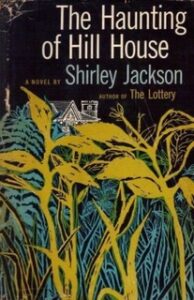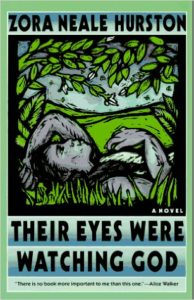The Haunting of Hill House and Their Eyes Were Watching God
If the book we choose to read is thin – say, less than 350 pages – the Mules will often read a second book. I don’t get it. It seems to me that one book is more than sufficient to fuel a good discussion. But I don’t complain. The elder Mules, those that make these decisions, are wise. I trust them.
In October, we read two books, neither of which I had even heard of before: The Haunting of Hill House by Shirley Jackson, and Their Eyes Were Watching God by Zora Neale Hurston. Usually, when we read two books, there is something that connects them. (In November, for example, we are going to read From Russia With Love and a biography of Ian Fleming.)
This time, as near as I could tell, there was no connection. The subject matter was different. So were the themes, styles, and genres.
But there was one thing that was true of both of them: They are superbly written.

The Haunting of Hill House (1959)
By Shirley Jackson
246 pages
The Haunting of Hill House is the story of six people that spend time in a supposedly haunted house. They include Dr. Montague, an occult scholar looking for solid evidence of a “haunting”; his wife, a believer in spirits; Theodora, a feisty young woman; Luke, the future heir of the house; and Eleanor, a fragile young woman that supposedly had experiences with poltergeists when she was young.
As the days pass, odd and scary things begin to happen. Mostly to Eleanor, who is the central character through which we come to understand the others.
We began our discussion by trying to identify the book’s genre. Was it a gothic horror novel? Or a psychological thriller? We could not agree. And so, we went on to discuss other matters. The novelty of the story, the development of the characters, the quality of the writing – and we disagreed about all that too.
That is not exactly right. Nearly all the assembled Mules, and those attending by Zoom, felt that it wasn’t a good book. The plot was not surprising. The characters were cliché. There were none of the twists and turns and surprises they wanted from a story of this type. It was just not interesting. There were, however, two Mules (GG and yours truly) that felt differently. We thought it was a very good book. And we thought it was very well written.
In support of our argument, I accused my fellow Mules of being dense. GG, averse to ad hominem attacks, made a case for the literary quality of the novel by reading the first paragraph out loud…
“No live organism can continue for long to exist sanely under conditions of absolute reality; even larks and katydids are supposed, by some, to dream. Hill House, not sane, stood by itself against its hills, holding darkness within; it had stood for eighty years and might stand for eighty more. Within, walls continued upright, bricks met neatly, floors were firm, and doors were sensibly shut; silence lay steadily against the wood and stone of Hill House, and whatever walked there, walked alone.”
Everyone had to admit: That was damn good writing.
Critical Reception
Although outnumbered at the meeting, GG and I weren’t the only critics that recognized the quality of this book. In The Magazine of Fantasy & Science Fiction, Damon Knight selected it as one of the 10 best genre books of 1959 and declared it to be “in a class by itself.” In 2018, The New York Times polled 13 respected horror novel writers to choose the scariest book of fiction they had ever read. Two of them, Carmen Maria Machado and Neil Gaiman, chose The Haunting of Hill House.
But the ultimate praise came from the ultimate horror fiction writer of our time, the one and only Stephen King. He called it “one of the finest horror novels of the late 20th century.”
Interesting
Shirley Jackson decided to write the book after reading about a group of 19th century “psychic researchers” who had studied a “haunted” house and reported their supposedly scientific findings to the Society for Psychic Research. After the book was published, she said, “No one can get into a novel about a haunted house without hitting the subject of reality head-on; either I have to believe in ghosts, which I do, or I have to write another kind of novel altogether.”

Their Eyes Were Watching God (1937)
By Zora Neale Hurston
219 pages
After defending The Haunting of Hill House for an hour or so, it was to GG’s and my relief that the Mules were unanimous in liking Their Eyes Were Watching God. They liked the story. And the main character. And the minor characters. And the themes. And the book’s literary qualities.
An example of the writing – the first paragraph:
“For some they come in with the tide. For others they sail forever on the horizon, never out of sight, never landing until the Watcher turns his eyes away in resignation, his dreams mocked to death by Time. That is the life of men.”
Their Eyes Were Watching God is the story of Janie Crawford’s life, from “a vibrant, but voiceless, teenage girl into a woman with her finger on the trigger of her own destiny.” It is, from what I’ve been told, a standard text for high schools today. It’s considered important in its exploration of feminism and the African American experience in Florida in the early 20th century.
Critical Reception
Initially, the book was slammed by Richard Wright and other leading figures of the Harlem Renaissance for perpetuating a stereotypical view of African Americans that, in Wright’s words, “eat and laugh and cry and work and kill; they swing like a pendulum eternally in that safe and narrow orbit in which America likes to see the Negro live: between laughter and tears.”
Hurston’s reputation was restored in the Black community in 1975 when Alice Walker published an essay in Ms.magazine (“In Search of Zora Neale Hurston”) that is largely credited with reviving interest in her work. “A people do not throw their geniuses away,” Walker is famously quoted as saying. “And if they are thrown away, it is our duty as artists and as witnesses for the future to collect them again for the sake of our children and, if necessary, bone by bone.”
The book was reissued two years later and has since appeared on many “100 best” lists.
